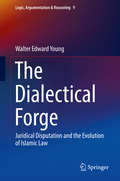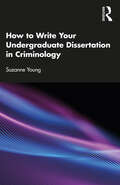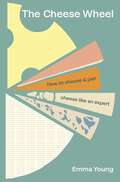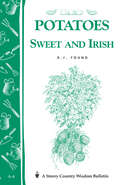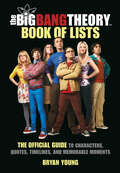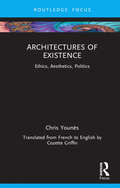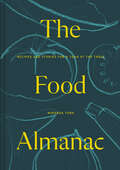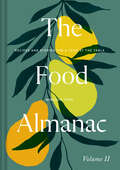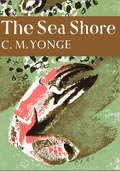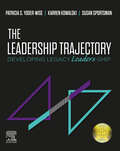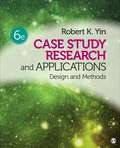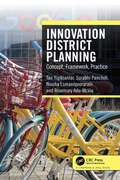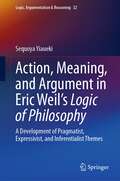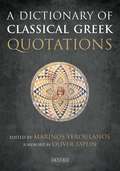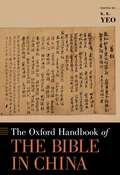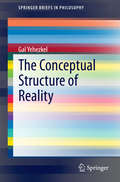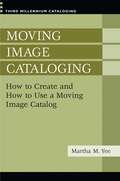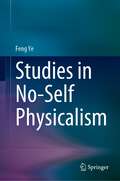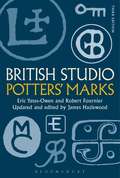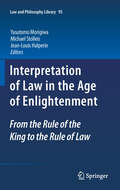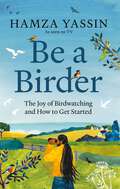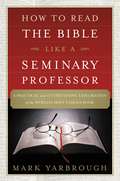- Table View
- List View
The Dialectical Forge: Juridical Disputation and the Evolution of Islamic Law (Logic, Argumentation & Reasoning #9)
by Walter Edward YoungThe Dialectical Forge identifies dialectical disputation (jadal) as a primary formative dynamic in the evolution of pre-modern Islamic legal systems, promoting dialectic from relative obscurity to a more appropriate position at the forefront of Islamic legal studies. The author introduces and develops a dialectics-based analytical method for the study of pre-modern Islamic legal argumentation, examines parallels and divergences between Aristotelian dialectic and early juridical jadal-theory, and proposes a multi-component paradigm—the Dialectical Forge Model—to account for the power of jadal in shaping Islamic law and legal theory.In addition to overviews of current evolutionary narratives for Islamic legal theory and dialectic, and expositions on key texts, this work shines an analytical light upon the considerably sophisticated “proto-system” of juridical dialectical teaching and practice evident in Islam’s second century, several generations before the first “full-system” treatises of legal and dialectical theory were composed. This proto-system is revealed from analyses of dialectical sequences in the 2nd/8th century Kitāb Ikhtilāf al-ʿIrāqiyyīn / ʿIrāqiyyayn (the “subject-text”) through a lens molded from 5th/11th century jadal-theory treatises (the “lens-texts”). Specific features thus uncovered inform the elaboration of a Dialectical Forge Model, whose more general components and functions are explored in closing chapters.
How to Write Your Undergraduate Dissertation in Criminology
by Suzanne YoungThis book provides a guide for undergraduate criminology and criminal justice students undertaking their final-year dissertation. It speaks to the specific challenges for criminology students who may wish to research closed institutions (such as prisons, courts, or the police) or vulnerable populations (such as people with convictions, victims of crime, or young people), and offers guidance on how to undertake research on these topics whilet avoiding many of the access and ethical obstacles. It takes students through each phase of the dissertation, from designing and planning the research to writing up and presenting the completed work. The complexities of undertaking research on sensitive topics and with criminal justice institutions are discussed throughout, offering an insight into some of the challenges that students may be faced with and suggestions to overcome obstacles. It offers practical guidance for empirical and library-based projects and provides students with suggested resources for accessing primary and secondary data. It utilises a mixture of worked examples, top tips, practical strategies, and student activities to ensure the dissertation is a manageable and enjoyable process. This book will be beneficial to all undergraduate criminology students who have to undertake either a library-based or empirical dissertation. The examples and activities in the book will also be useful for dissertation supervisors who can use them to support their dissertation students.
How to Write Your Undergraduate Dissertation in Criminology
by Suzanne YoungThis book provides a guide for undergraduate criminology and criminal justice students undertaking their final-year dissertation. It speaks to the specific challenges for criminology students who may wish to research closed institutions (such as prisons, courts, or the police) or vulnerable populations (such as people with convictions, victims of crime, or young people), and offers guidance on how to undertake research on these topics whilet avoiding many of the access and ethical obstacles. It takes students through each phase of the dissertation, from designing and planning the research to writing up and presenting the completed work. The complexities of undertaking research on sensitive topics and with criminal justice institutions are discussed throughout, offering an insight into some of the challenges that students may be faced with and suggestions to overcome obstacles. It offers practical guidance for empirical and library-based projects and provides students with suggested resources for accessing primary and secondary data. It utilises a mixture of worked examples, top tips, practical strategies, and student activities to ensure the dissertation is a manageable and enjoyable process. This book will be beneficial to all undergraduate criminology students who have to undertake either a library-based or empirical dissertation. The examples and activities in the book will also be useful for dissertation supervisors who can use them to support their dissertation students.
The Cheese Wheel: How to choose and pair cheese like an expert
by Emma Young'Delicious! Emma writes with such clarity and passion' NED PALMER, bestselling author A Cheesemonger's History of the British Isles'Emma's expert take is brilliantly refreshing. What a triumph' HELEN MCGINN, Drinks Expert BBC Saturday Kitchen'Fabulous, fun and factual' MELISSA HEMSLEY__________Do you know your Brie from your Beaufort, your Reblochon from your Roquefort? Whatever your cheese expertise, this book is for you!With over 110 cheeses covered, using The Cheese Wheel, you can:- Discover the finest new cheeses from around the world- Master how to taste cheese and describe what you like/dislike- Find out the perfect drink to pair with your cheese- Design your own cheeseboard- And much more...With experience as a cheesemonger, cheese maker and cheese awards judge, Emma Young brings her comprehensive knowledge to the page in this innovative flavour-based guide to cheese. Each cheese profile includes fascinating notes on its origins, what drink it pairs best with, why you must try it, and other cheeses it complements for your next cheese board.So, whether you consider yourself a cheese connoisseur or are simply curious about the differences between a Cheddar, Comté and Caerphilly, this is an essential companion to have on your shelves.__________'The book on cheese we have been waiting for' REGULA YSEWIJN'A fun and informative book' RACHEL KHOO'An essential read for anyone who adores cheese' JAMES GOLDING, Group Chief Director THE PIG Hotel
Potatoes, Sweet and Irish: Storey's Country Wisdom Bulletin A-04 (Storey Country Wisdom Bulletin)
by D. J. YoungSince 1973, Storey's Country Wisdom Bulletins have offered practical, hands-on instructions designed to help readers master dozens of country living skills quickly and easily. There are now more than 170 titles in this series, and their remarkable popularity reflects the common desire of country and city dwellers alike to cultivate personal independence in everyday life.
The Big Bang Theory Book of Lists: The Official Guide to Characters, Quotes, Timelines, and Memorable Moments
by Bryan YoungCelebrate the nerdiest friend group with this ultimate fan guide packed with trivia, facts, and memories from all twelve seasons of The Big Bang Theory. With more than 100 inventive lists, charts, and timelines, The Big Bang Theory Book of Lists offers fans a creative way of looking at and celebrating the iconic and beloved early 2000s sitcom. Revisit some of your favorite moments, pairings, cameos, and geeky references (or test your super-fan knowledge) with these fun groupings exploring the variables of life in apartment 4A.Lists include:Timelines of all the characters, their romantic partnerships, vows, and weddings Analysis of Sheldon's Public Restroom KitAll of Penny&’s Relationship AdvicePictorial Records for Sheldon, Leonard, Penny, Howard, Raj, Amy, and BernadetteRecord of all of the guests (cameos) in the apartmentDiagram of The Universe of All WomenEverything that's in Bernadette's Grab BagA break-down of all of Sheldon's geeky shirts and their referencesAnd more!Illustrated with full-color photographs and visuals from the show throughout, The Big Bang Theory Book of Lists is an officially licensed, must-have collector's item for the ultimate fan.THE BIG BANG THEORY and all related characters and elements © & ™ Warner Bros. Entertainment Inc. (s22)
Architectures of Existence: Ethics, Aesthetics, Politics
by Chris YounèsArchitectures of Existence proposes that philosophical thinking (ecosophical thinking) can inform the way we engage with our world and its inhabitants, as architects, designers and planners, but also as individuals, as people, and as a society. In Art et existence, Maldiney states: "For us, to inhabit is to exist". This book aims to unfold, extend, articulate and thicken this postulate by interweaving architecture, city, landscape, literature and philosophy. It takes up the synergistic lines of long-term research carried out from an ecosophical perspective. Such an attitude explores an art of existing in multiplicity, singularity and openness, manifesting the critical dimension through a reinterpretation of the knotting of the trajectories of time, humanity and its becoming. Insisting on what is between things and beings as well as on what is happening, regenerating, recycling, reviving, saving, diversifying, sparing, recreating, meditating: and so caring. These are all eco-rhythms of a different type between human and non-human, to consider ourselves in the world. In an era of uncertainty and climate threats, this book develops the margins of possibility offered by the subject of architecture. This book will be of interest to researchers and students of architecture, urban planning and philosophy.
Architectures of Existence: Ethics, Aesthetics, Politics
by Chris YounèsArchitectures of Existence proposes that philosophical thinking (ecosophical thinking) can inform the way we engage with our world and its inhabitants, as architects, designers and planners, but also as individuals, as people, and as a society. In Art et existence, Maldiney states: "For us, to inhabit is to exist". This book aims to unfold, extend, articulate and thicken this postulate by interweaving architecture, city, landscape, literature and philosophy. It takes up the synergistic lines of long-term research carried out from an ecosophical perspective. Such an attitude explores an art of existing in multiplicity, singularity and openness, manifesting the critical dimension through a reinterpretation of the knotting of the trajectories of time, humanity and its becoming. Insisting on what is between things and beings as well as on what is happening, regenerating, recycling, reviving, saving, diversifying, sparing, recreating, meditating: and so caring. These are all eco-rhythms of a different type between human and non-human, to consider ourselves in the world. In an era of uncertainty and climate threats, this book develops the margins of possibility offered by the subject of architecture. This book will be of interest to researchers and students of architecture, urban planning and philosophy.
The Food Almanac: Recipes And Stories For A Year At The Table
by Miranda YorkSHORTLISTED FOR THE FORTNUM & MASON FOOD AND DRINK AWARDS 2021 The Food Almanac is a seasonal collection of recipes and stories celebrating the joy of food – a dazzling, diverse mix of memoir, history, short stories and poems alongside recipes, cooking tips, menus and reading lists.
The Food Almanac: Volume Two
by Miranda YorkThe Food Almanac II is an annual, seasonal collection of recipes and stories celebrating the joy of food – a dazzling, diverse mix of memoir, history, short stories and poems alongside recipes, cooking tips, menus and reading lists.
The Sea Shore (Collins New Naturalist Library #12)
by C. M. YongeA comprehensive, authoritative account of the natural history of the seashore, from earliest times to the present day.
The Leadership Trajectory E-Book: Developing Legacy Leaders-Ship
by Patricia S. Yoder-Wise Karren Kowalski Susan SportsmanDesigned to help you excel at every stage of your leadership path, this unique and practical text is organized around a nursing and health care leadership trajectory of three core areas — The Strategies, The Personal, and The Environment. The Strategies covers necessary actions that you need to take to become more influential in any environment to move yourself and your people to greater contributions. The Personal relates to the concepts that you must develop and hone to increase your influence. The Environment reinforces how you can exercise the strategies and personal factors in this leadership model through assessing the situations in which you find yourself.Reflection questions in each chapter emphasize the importance of the process being discussed as a strategy for growth and to facilitate active reading.LL Alert! boxes cite examples of actions and statements to avoid.LL Lineup summaries at the end of each chapter help you create an action plan related to the chapter topic.Practical approach features straightforward, concise content that addresses only the most relevant information on the subject of each chapter.The Strategies covers necessary actions that you need to take to become more influential in any environment to move yourself and your people to greater contributions.The Personal relates to the concepts that you must develop and hone to increase your influence.The Environment reinforces how you can exercise the strategies and personal factors in this model through assessing the situations in which you find yourself.
Case Study Research and Applications: Design and Methods (Sixth Edition) (PDF)
by Robert YinThe Sixth Edition of Robert K. Yin's bestseller provides a complete portal to the world of case study research. Offering comprehensive coverage of the design and use of the case study method in addition to an integration of applications, the book gives readers access to exemplary case studies drawn from a wide variety of academic and applied fields. The integration of applications will enable users to see more directly how concrete case studies can implement the principles of case study research methods.
Innovation District Planning: Concept, Framework, Practice
by Tan Yigitcanlar Surabhi Pancholi Niusha Esmaeilpoorarabi Rosemary Adu-McVieThis book aims to fill the knowledge gap on how to plan, develop and manage innovation districts that are competitive in terms of both productivity and quality of living, justifying the massive investment put into place and at the same time doing both in a delicate and harmonious way.There is a need for smart urban land use that is wired with both hard infrastructures (e.g., telecommunication and transport) and soft infrastructures (e.g., diversity and tolerance). The reader learns this knowledge through conceptual expansions for key insights, frameworks for potential and performance assessment and best practices for global innovation districts. The authors begin innovation district planning with the role and effectiveness of planning a branding in the development of innovation districts. The next key topic of place making is recognised as a key strategy for supporting knowledge generation and innovation activities in the contemporary innovation districts. Another important topic is place quality where the reader learns to identify and classify indicators of place quality by studying global innovation districts best practices. The reader also expands their understanding on the classification of innovation districts based on their key characteristics through a methodological approach. The book concludes with district smartness studied through the socio-cultural role played by anchor universities in facilitating place making in innovation districts. Smart campuses, enabled by digital transformation opportunities in higher education, are seen as a miniature replica of smart cities and serve as living labs for smart technology.The book serves as a repository for scholars, researchers, postgraduate and undergraduate students as it communicates the complex innovation district phenomenon in an easy-to-digest form by providing both the big picture view and specifics of each component of that view.
Innovation District Planning: Concept, Framework, Practice
by Tan Yigitcanlar Surabhi Pancholi Niusha Esmaeilpoorarabi Rosemary Adu-McVieThis book aims to fill the knowledge gap on how to plan, develop and manage innovation districts that are competitive in terms of both productivity and quality of living, justifying the massive investment put into place and at the same time doing both in a delicate and harmonious way.There is a need for smart urban land use that is wired with both hard infrastructures (e.g., telecommunication and transport) and soft infrastructures (e.g., diversity and tolerance). The reader learns this knowledge through conceptual expansions for key insights, frameworks for potential and performance assessment and best practices for global innovation districts. The authors begin innovation district planning with the role and effectiveness of planning a branding in the development of innovation districts. The next key topic of place making is recognised as a key strategy for supporting knowledge generation and innovation activities in the contemporary innovation districts. Another important topic is place quality where the reader learns to identify and classify indicators of place quality by studying global innovation districts best practices. The reader also expands their understanding on the classification of innovation districts based on their key characteristics through a methodological approach. The book concludes with district smartness studied through the socio-cultural role played by anchor universities in facilitating place making in innovation districts. Smart campuses, enabled by digital transformation opportunities in higher education, are seen as a miniature replica of smart cities and serve as living labs for smart technology.The book serves as a repository for scholars, researchers, postgraduate and undergraduate students as it communicates the complex innovation district phenomenon in an easy-to-digest form by providing both the big picture view and specifics of each component of that view.
Action, Meaning, and Argument in Eric Weil's Logic of Philosophy: A Development of Pragmatist, Expressivist, and Inferentialist Themes (Logic, Argumentation & Reasoning #32)
by Sequoya YiauekiThis volume investigates Eric Weil’s innovative conceptualization of the place of violence in the philosophical tradition with a focus on violence’s relationship to language and to discourse. Weil presents violence as the central philosophical problem. According to this reading, the western philosophical tradition commonly conceptualizes violence as an expression of error or as a consequence of the weakness of will. However, by doing so, it misses something essential about the role that violence plays in our conceptual development as well as the place violence holds in our discursive practices.The author draws comparisons between Weil’s work and that of Robert Brandom. Brandom’s inferentialism creates a sophisticated program at the junction of pragmatics and semantics, philosophy of language, logic, and philosophy of mind. The monograph builds on these insights in order to show how an inferentialist reading of Eric Weil is fruitful for both Weilian studies and for inferentialism. This volume will notably be of interest to scholars in philosophy, argumentation theory, and communication studies.
A Dictionary of Classical Greek Quotations
by Marinos Yeroulanos'Only god is truly wise: human wisdom is of little or no value', declaimed Plato in his Apology. And yet the ancient Greeks, including Plato himself, more than any other people of antiquity were fascinated by the pursuit of the wisdom they called philosophia. That search for knowledge involved an extensive use of maxims and quotations, as we can see from those expressions of Homer prefaced by the phrase 'as people say'. Classical Greek lore and sagacity have throughout history continued to provide inspiration to figures as diverse as the Church Fathers, Shakespeare, Nietzsche, Marx and John F Kennedy. Indeed, Homer, the Seven Sages and the Pre-Socratic philosophers are still extensively quoted in all the major western languages, while the admired sayings of Heraclitus, for instance, are known only through his quotations, his actual writings having long been lost. Yet for all their popularity and ubiquity, until now there has been no single resource for these quotations to which interested readers might turn. This unique and handsome reference book offers one of the most comprehensive selections of Greek quotations ever committed to print. Organised alphabetically, with the original Greek followed by an accompanying English translation, it collects some 7500 entries, ranging from the archaic period to late antiquity, and across philosophy, drama, poetry, history, science and medicine. Containing a full list of translators and of abbreviations, its index of key words enables the fast and efficient sourcing of each entry. This is a handbook designed for years of pleasurable and profitable browsing. Many readers may find that the views expressed twenty centuries ago, and now helpfully contained between one set of covers, are as pertinent and provocative today as they were then.
The Oxford Handbook of the Bible in China (Oxford Handbooks)
by K. K. YeoIs the Bible an ancient text, a mere relic of the past? Is the Bible a "Western" product, irrelevant to the "East"? Can the Bible be imagined as a living text for twenty-first century China? The Oxford Handbook of the Bible in China provides surprising answers and discoveries related to the Bible and its place in China over the last thirteen hundred years. Forty-seven essays address the translation of the Bible into China's languages and dialects, expression of the Bible in Chinese literary and religious contexts, Chinese biblical interpretations and methods of reading, and the reception of the Bible in the institutions and arts of China. Each essay consists of a comprehensive yet concise treatment set in a historical frame on topics as wide-ranging as: the first Chinese Bibles, Chinese Nestorian Christianity, Bibles of minority nationalities, Sino-Christian theology, printed illustrations of the Gospel in China, the Bible and Chinese films, Chinese calligraphy and the biblical texts, Chinese Classics and the Bible, and Chinese society and politics. This expansive and unique volume presents insightful, succinct, and provocative evidence about and interpretations of encounters between the Bible and China for centuries past, continuing into the present, and likely prospects for the future.
The Conceptual Structure of Reality (SpringerBriefs in Philosophy)
by Gal YehezkelThis book describes a novel conception of reality, one that uniquely incorporates an idealistic view of existence with an account of objectivity. It introduces a general model of conceptual analysis and demonstrates its effectiveness in exposing and establishing the existence of conceptual ties. The book begins by introducing the tools and principles needed for the conceptual analysis undertaken in chapters that follow. Next, it presents a detailed examination into existence, contingency, idealism, self-consciousness and natural laws. In the process, the author critically examines the conceptions of existence held by Kant, Frege and Russell; argues that the determinations of past, present and future are subjective in the sense that they imply the existence of consciousness in relation to which they are fixed; shows that every possible reality includes sufficient conditions for self-consciousness; and confronts the question of the "uniformity of nature," which states that reality is subject to natural laws. In the end, the idealistic conception of reality developed in this book implies that existence is relative, rather than absolute, in the sense that it is determined in relation to a point of view internal to reality. This view of existence implies that reality necessarily exists.
Moving Image Cataloging: How to Create and How to Use a Moving Image Catalog (Third Millennium Cataloging)
by Martha M. YeeLibraries, archives, and museums hold a wide variety of moving images. all of which require the same level of attention to issues of organization and access as their print counterparts. Consequently, the people who create collection level records and metadata for these resources need to be equally conversant in the principles of cataloging. Martha Yee covers both descriptive (AACR2R, AMIM, and FIAF rules) and subject cataloging (with a focus on LCSH). In the process, the reader is encouraged to think critically and to be prepared to make decisions in ambiguous situations where solutions to problems are not always obvious or clearly dictated by specific rules.
Studies in No-Self Physicalism
by Feng YeThis book demonstrates how a radical version of physicalism (‘No-Self Physicalism’) can offer an internally coherent and comprehensive philosophical worldview. It first argues that a coherent physicalist should explicitly treat a cognitive subject merely as a physical thing and should not vaguely assume an amorphous or even soul-like subject or self. This approach forces the physicalist to re-examine traditional core philosophical notions such as truth, analyticity, modality, apriority because our traditional understandings of them appear to be predicated on a cognitive subject that is not literally just a physical thing.In turn, working on the assumption that a cognitive subject is itself completely physical, namely a neural network-based robot programmed by evolution (hence the term ‘No-Self’), the book proposes physicalistic theories on conceptual representation, truth, analyticity, modality, the nature of mathematics, epistemic justification, knowledge, apriority and intuition, as well as a physicalistic ontology. These are meant to show that this No-Self Physicalism, perhaps the most minimalistic and radical version of physicalism proposed to date, can accommodate many aspects that have traditionally interested philosophers. Given its refreshingly radical approach and painstakingly developed content, the book is of interest to anyone who is seeking a coherent philosophical worldview in this age of science.
British Studio Potters' Marks
by Eric Yates-Owen Robert Fournier James HazlewoodThis new edition of Eric Yates-Owen and Robert Fournier's classic book on British studio potters' marks contains new and revised entries for many potters, with up-to-date information about the artists' styles, marks and addresses.Entries are arranged alphabetically, with each entry giving biographical data, information on the type of ceramics produced, the location of the pottery and dates indicating when marks have changed, as well as images of the different marks used. Three useful indexes enable the reader to search by mark rather than maker, in various categories such as creatures, monograms and signs.Revised by expert collector James Hazlewood, British Studio Potters' Marks, third edition, is the essential reference guide for collectors of British studio pottery.
Interpretation of Law in the Age of Enlightenment: From the Rule of the King to the Rule of Law (Law and Philosophy Library #95)
by Yasutomo Morigiwa, Michael Stolleis and Jean-Louis HalperinA collaboration of leading historians of European law and philosophers of law and politics identifying and explaining the practice of interpretation of law in the 18th century. The goal: establishing the actual practice in the Age of Enlightenment, and explaining why this was the case. The ideology of the Age was that law, i.e., the will of the sovereign, can be explicitly and appropriately stated, thus making interpretation redundant. However, the reality was that in the 18th century, there was no one leading source of national law that would be the object of interpretation. Instead, there was a plurality of sources of law: the Roman Law, local customary law, and the royal ordinance. However, in deciding a case in a court of law, the law must speak with one voice. Hence, interpretation to unify the norms was inevitable. What was the process? What role did justification in terms of reason, the hallmark of the Enlightenment, play? These are some of the questions addressed.
Be a Birder: The joy of birdwatching and how to get started
by Hamza Yassin'He is delight and joy personified' - MARIAN KEYES'Set to become BBC's next David Attenborough' - DAILY MAIL'Brings a little bit of joy to us all' - GUARDIAN Discover the wonderful world of birdwatching with wildlife cameraman Hamza Yassin - winner of BBC One's Strictly Come Dancing 2022. 'Birds have been with me my entire life - from the colourful weaver birds on the banks of the Nile in Sudan to the magpies of Newcastle, from the roosting peregrine falcons near my parents' house in Northampton to the white-tailed eagles on the west coast of Scotland. I love them. If you take the time to stop and listen, you'll see the world through different eyes. It's all out there, waiting for you to find it. And it might just bring you as much joy as it's brought me.'Journey along with Hamza in Be a Birder as he recounts stories of his birding adventures, and shares tips and tricks to help you get started in birdwatching.In this beautifully illustrated guide, featuring fifty of Hamza's favourite birds, you will learn how to start identifying birds, understand their behaviour and movements, and find even more exciting birds, wherever you are. Starting with the goldfinch in your garden, to tawny owls in woodlands, to the elusive kingfisher near rivers and marshes, you will build your birdwatching confidence and push yourself further afield to find new feathered wonders.Encouraging us all to stop, step outside and listen, Be a Birder is both a practical guide and a joyous celebration of these incredible creatures. Once you start looking for them, and with Hamza as your guide, your world will be forever changed.
How to Read the Bible Like a Seminary Professor: A Practical and Entertaining Exploration of the World's Most Famous Book
by Mark YarbroughMany people admire and even revere the Bible, but they simply do not understand what they read, much less how to study Scripture. Yet they wish they could. In this insightful and alternately amusing guide, Professor Mark Yarbrough shows how easy and gratifying it is to unlock the hidden truths of God's Word and to discover a world where reading the Bible doesn't just satisfy our curiosity, but changes our life. To do this, the reader will step into the seminary classroom and observe the practical principles-the tricks of the trade-for becoming a more effective student of the Bible. But Yarbrough has made sure that his writing style and general approach will be appealing to both academic students and those involved in lay-level Bible study. Real life is whacky and in-your-face. Studying Scripture should be too.
